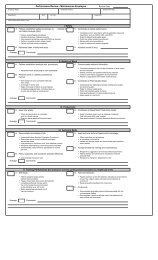Building Operating Management September 2011 - FacilitiesNet
Building Operating Management September 2011 - FacilitiesNet
Building Operating Management September 2011 - FacilitiesNet
You also want an ePaper? Increase the reach of your titles
YUMPU automatically turns print PDFs into web optimized ePapers that Google loves.
16<br />
buildingoperatingmanagement<br />
SEPTEMBER <strong>2011</strong><br />
CLOSE-UP: UTILITIES<br />
Incentive Programs Can<br />
Help Save Energy Dollars<br />
by james piper, contributing editor<br />
Rising demand for electricity has led utility companies to seek ways to<br />
reduce the need to invest in new generation facilities, system power<br />
purchases, and additional transmission and distribution capacity.<br />
The problem for utilities is especially critical at periods of peak<br />
demand. As a result, utilities have devoted significant resources to<br />
programs designed to reduce consumption, particularly at peak.<br />
Some utility incentive programs have been designed<br />
to persuade facilities to reduce overall electricity use. For example,<br />
utilities may offer grants and rebates to customers to<br />
assist in the purchase of energy-efficient products. Other programs<br />
provide awareness and education resources to aid facility<br />
managers in implementing energy efficiency building practices.<br />
$2.5 billion<br />
Other types of incentives are tied to peak demand<br />
reduction. These programs do not necessarily<br />
reduce total energy use within a facility. Instead, they<br />
are designed to help customers curtail their energy<br />
use during hours of peak demand, typically between<br />
Utility rebate programs<br />
11 a.m. and 7 p.m. on weekdays, or to shift demand to hours when<br />
flourished in the early ‘90s, the demand for electricity is lower: evenings, nights and weekends.<br />
then waned as the industry<br />
Traditionally, all but the largest customers paid for electricity at<br />
a rate based on average annual generation costs. While this pricing<br />
moved toward deregulation.<br />
scheme did reimburse utilities for the cost of generation and delivery,<br />
Since then, there has been a it did not reflect the higher costs incurred by utilities when they had<br />
resurgence in utility energy to either purchase power or bring higher cost peaking generators online<br />
to meet the highest periods of peak demand. Nor did it cover the<br />
incentive programs, with<br />
cost of building and maintaining the infrastructure needed to meet<br />
total funding from utilities peak demand. The pricing scheme also did not offer customers any<br />
or state energy offices hitting incentive to reduce their energy use during peak demand periods.<br />
$2.5 billion in 2008.<br />
For more, go to:<br />
www.facilitiesnet.com/12123bom<br />
How Demand Response Works<br />
A variety of programs have been developed that focus directly on<br />
reducing peak demand. For example, utilities have offered lower, “interruptible”<br />
rates to large facilities that would agree to reduce consumption<br />
upon request. But there were complications with these programs that led<br />
many utilities to morph them into demand response programs.<br />
The most common approach to current demand response programs<br />
centers around a demand response event. Demand response events<br />
are those occasions when the utility foresees the demand for electricity<br />
increasing to the point where outside purchases of electricity will have<br />
to be made or higher cost peak generating equipment will have to be<br />
brought online in order to meet demand. A demand response event also<br />
may be the result of equipment failure within the distribution system<br />
that could result in an overload to a portion of the system.<br />
When the utility determines that demand must be reduced, those<br />
participating in the program are notified of the demand response event.<br />
Depending on the specifics of the program, participants are given an<br />
advance notice of 30 minutes to two hours. Participants are then asked<br />
to take steps to reduce their demand for electricity according to a preplanned<br />
load reduction scheme. In smaller and medium-sized facilities,<br />
customers typically turn off certain electrical loads, such as building airconditioning<br />
systems, for the duration of the demand response event.<br />
Larger facilities and those with a building automation system can rotate<br />
Green Energy<br />
Programs<br />
These programs offer grants<br />
to commercial and institutional<br />
facilities for renewable energy<br />
systems, including photovoltaic,<br />
solar water heating, solar<br />
space heating, wind, fuel cell<br />
and geothermal-based systems.<br />
Most programs offer rebates<br />
to cover part of the installation<br />
costs and other incentives<br />
based on the annual kWh the<br />
system displaces. “To do’s” for<br />
facility managers: ask if the utility<br />
is offering grants and incentives<br />
and if their facility is eligible to<br />
participate, then perform a site<br />
assessment to see if the facility<br />
qualifi es. Funding is limited, and<br />
competition is high.<br />
— james piper<br />
Many utility programs<br />
are designed to help<br />
customers curtail<br />
energy use during hours<br />
of peak demand, typically<br />
between 11 a.m. and<br />
7 p.m. on weekdays,<br />
or to shift consumption<br />
to hours when demand<br />
for electricity is lower:<br />
evenings, nights and<br />
weekends.





